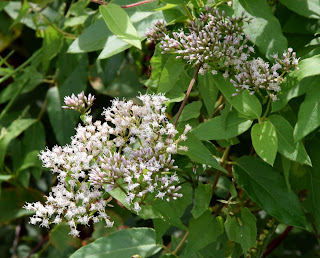Quality wild roadsides are shrinking. They fall victim to a variety of forces: development, overzealous utility crews, and man’s desire to control nature for tidiness or conformity. In the absence of these forces, roadsides can be incredibly diverse collections of native plants that support pollinators of all kinds (not to mention the birds that eat them).
 |
| Desmodium paniculatum |
Not far from my house is a wonderful roadside with a wet edge and a long run. I have enjoyed exploring the plants there for years. Unfortunately, it is under some power lines.
Two years ago, contractors for the utility company came through the area, hacking and spraying in a grotesque spectacle of plant ignorance and disregard for life of any kind.
Mangled branch ends and a seemingly endless line of dead vegetation replaced what would have been a late summer feast for the insects.
Last year, the non-native plants in the area grew back quickly. Japanese honeysuckle and non-native grasses seemed hardly affected by the poisonous punishment. I was afraid that their rapid growth would out-compete the efforts of the native plants to come back; by fall of last year, my fear had grown as few flowers showed up.
 |
| Apios americana |
I am happy to report that the natives are back this year and looking fine! Some surely came from roots while many others likely sprouted from the seed bank. While I am sure that many passersby see this as a riotous tangle, anyone that knows plants can see the immense diversity here, and there were insects galore.
Here is what is blooming there this week:
Vines: devil's darning needles (Clematis virginiana), ground-nut (Apios americana), hempvine (Mikania scandens)
Perennials: anise-scented goldenrod (Solidago odora), wingstem (Verbesina alternifolia), thoroughwort (Eupatorium serotinum), ironweed (Vernonia gigantea), Indian plantain (Arnoglossum atriplicifolium), panicled tick trefoil (Desmodium paniculatum), woodland sunflower (Helianthus divaricatus), pokeweed (Phytolacca americana)
Annuals/Biennials: jewelweed (Impatiens capensis), evening primrose (Oenothera biennis)
 |
| Clematis virginiana |
 |
| Impatiens capensis |
 |
| Mikania scandens |
 |
| Verbesina alternifolia |
 |
| Vernonia gigantea |
As I turned to go, a flutter caught my eye and I stayed to watch a monarch butterfly cruise over the buffet of flowers. For the moment, all is right with this little piece of the world again.
Wouldn't it be nice if some kind of management program could be worked out with "the forces that be"?
ReplyDeletethere is a way: http://flawildflowers.org/fpwa
DeleteWith Eleonor'spermission we used information from their website to create a brochure for Georgia.
Hi there. I think your photo that claims to show our native Clematis virginiana actually shows the invasive C. terniflora (sweet autumn clematis). It's my understanding that C. virginiana has toothed-leaves where the edges of C. terniflora leaves are smooth or entire, like the ones in your photo...
ReplyDeleteI appreciate your comments, but if you click on the picture and look closely you can see the teeth. I am aware of the differences.
Delete